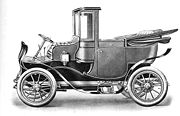.gif)
Rolls-Royce V-8 (1905)
Encyclopedia
- For details of the L410 V8 engine developed in the 1950s for use in Rolls-Royce and Bentley automobiles, see Rolls-Royce - Bentley L Series V8 engineRolls-Royce - Bentley L Series V8 engineThe Crewe built Rolls-Royce - Bentley L Series V8 engine was used on many Rolls-Royce and Bentley motor cars in the four decades after its introduction in 1959...

Rolls-Royce Limited
Rolls-Royce Limited was a renowned British car and, from 1914 on, aero-engine manufacturing company founded by Charles Stewart Rolls and Henry Royce on 15 March 1906 as the result of a partnership formed in 1904....
in 1905 intended to compete with the then popular electric car
Electric car
An electric car is an automobile which is propelled by electric motor, using electrical energy stored in batteries or another energy storage device. Electric cars were popular in the late-19th century and early 20th century, until advances in internal combustion engine technology and mass...
s used in towns.
Claude Johnson, business partner of C. S. Rolls
Charles Rolls
Charles Stewart Rolls was a motoring and aviation pioneer. Together with Frederick Henry Royce he co-founded the Rolls-Royce car manufacturing firm. He was the first Briton to be killed in a flying accident, when the tail of his Wright Flyer broke off during a flying display near Bournemouth,...
suggested there would be a market for an internal combustion engined car that could take on the electric car market. To do this it would have to be silent, free of vibration and smoke free. The engine would also have to be mounted under the car to give the appearance of a town brougham
Brougham (car body)
In the 1930s, a brougham was a two-door or four-door sedan, especially one electrically driven. The term was also applied to a vehicle similar to a limousine but with an outside seat in front for the chauffeur and an enclosed cabin behind for the passengers...
and so needed to be very shallow.
To compete with early electric car
Electric car
An electric car is an automobile which is propelled by electric motor, using electrical energy stored in batteries or another energy storage device. Electric cars were popular in the late-19th century and early 20th century, until advances in internal combustion engine technology and mass...
s, the engine was a completely new design with smoothness and quietness as top priorities, with power a secondary consideration. Production of the Rolls-Royce V-8 predated by a decade the first mass production
Mass production
Mass production is the production of large amounts of standardized products, including and especially on assembly lines...
of a V8 engine, by Cadillac
Cadillac
Cadillac is an American luxury vehicle marque owned by General Motors . Cadillac vehicles are sold in over 50 countries and territories, but mostly in North America. Cadillac is currently the second oldest American automobile manufacturer behind fellow GM marque Buick and is among the oldest...
.
Henry Royce designed the engine in the form of a 90 degree, side valve
Flathead engine
A flathead engine is an internal combustion engine with valves placed in the engine block beside the piston, instead of in the cylinder head, as in an overhead valve engine...
, 3535 cc, V-8
V8 engine
A V8 engine is a V engine with eight cylinders mounted on the crankcase in two banks of four cylinders, in most cases set at a right angle to each other but sometimes at a narrower angle, with all eight pistons driving a common crankshaft....
. To reduce fumes the then common drip lubrication was replaced by a pressure system. The power also seems to have been limited to maximise smooth running.
Two body styles were proposed, a Landaulet par Excellence to attack the town electric market and the Legalimit. In reality, the Legalimit could travel at 26 miles per hour (11.6 m/s) but the engine was governed
Governor (device)
A governor, or speed limiter, is a device used to measure and regulate the speed of a machine, such as an engine. A classic example is the centrifugal governor, also known as the Watt or fly-ball governor, which uses a rotating assembly of weights mounted on arms to determine how fast the engine...
so as not to exceed the legal speed limit in Britain at the time of 20 miles per hour (8.9 m/s).
The Legalimit had the engine conventionally mounted at the front but under a very low bonnet. Only one example of the V-8 was sold, a Legalimit (chassis number 40518) to Sir Alfred Harmsworth. This was later taken back by the factory. All three cars then seem to have been used as works cars or for customer visits. Rolls ordered three more chassis for delivery in 1906 but there is no evidence these were ever made.
Although the car cannot be judged a success, lessons were learned from the engine design that were later used on the six cylinder models which helped establish the Rolls-Royce name.
The 1905 V-8 is the only car model made by Rolls-Royce of which no example survives. Though none survive, Rolls-Royce at least emerges as the first to conceive of a passenger car designed from the outset as a V-8.

